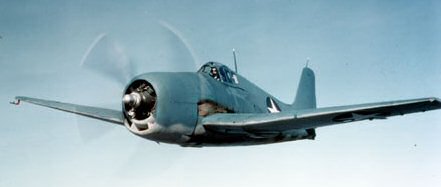F6F Hellcat
 From Conservapedia - Reading time: 2 min
From Conservapedia - Reading time: 2 min
The F6F Hellcat was the plane that turned the tide for America in World War II. It replaced the F4F Wildcat, and like its predecessor, had an air-cooled piston engine and six heavy machine guns. First operational in 1943, this Grumman fighter plane gave air supremacy to U.S. forces in the Pacific, shooting down over 5100 enemy aircraft for the loss of only 270 Hellcats in aerial combat. More Japanese planes were shot down by this model than by any other plane. The top scoring ace in the Hellcat was David McCampbell, who scored 34 aerial victories in the Pacific theater while serving on board the USS Essex.[1]
The high point of the Hellcat's career was the Battle of the Philippine Sea, the first part of which was known as the "Marianas Turkey Shoot". When Japanese carrier planes struck at American carriers covering the landings at Saipan, defending Hellcats shot down over 350 of them, for the loss of only 17 Hellcats.[2] Most of the attackers never even came within sight of the American fleet.
Two squadrons of Hellcats saw action in Europe as well, supporting the Allied landings in southern France in August (Operation Anvil). The Hellcats, flying from the carriers Kasaan Bay and Tulagi, performed close air support, interdiction, and gunnery spotting duties, in addition to scoring eight aerial victories (five bombers and three Ju-52 transports). Eleven F6Fs were lost to all causes, with at least one pilot killed.[3]
After World War II, the F6F's successor as the US Navy's frontline fighter was the Grumman F8F Bearcat.
Foreign Users[edit]
The Royal Navy acquired 250 Hellcats via Lend-Lease starting in late 1943, and they saw action over occupied Norway, in the Mediterranean, and in the Far East.
France also bought F6Fs after the war, many of which saw action in the First Indochina War.[4]
References[edit]
- ↑ Aces, by William Yenne, 2000
- ↑ Clash of the Carriers: the True Story of the Marianas Turkey Shoot of World War II, by Barrett Tillman, New American Library, 2005
- ↑ Hellcat Aces of World War 2, by Barrett Tillman, Osprey Publishing, 1996
- ↑ The Illustrated Guide to Naval Aircraft, by Francis Grosby, Anness Publishing, 2008
Links[edit]
- F6F Hellcat
- Grumman F6F Hellcat at the Warbirds Resource Group
- Nighttime Dogfight for the F6F at YouTube
 KSF
KSF